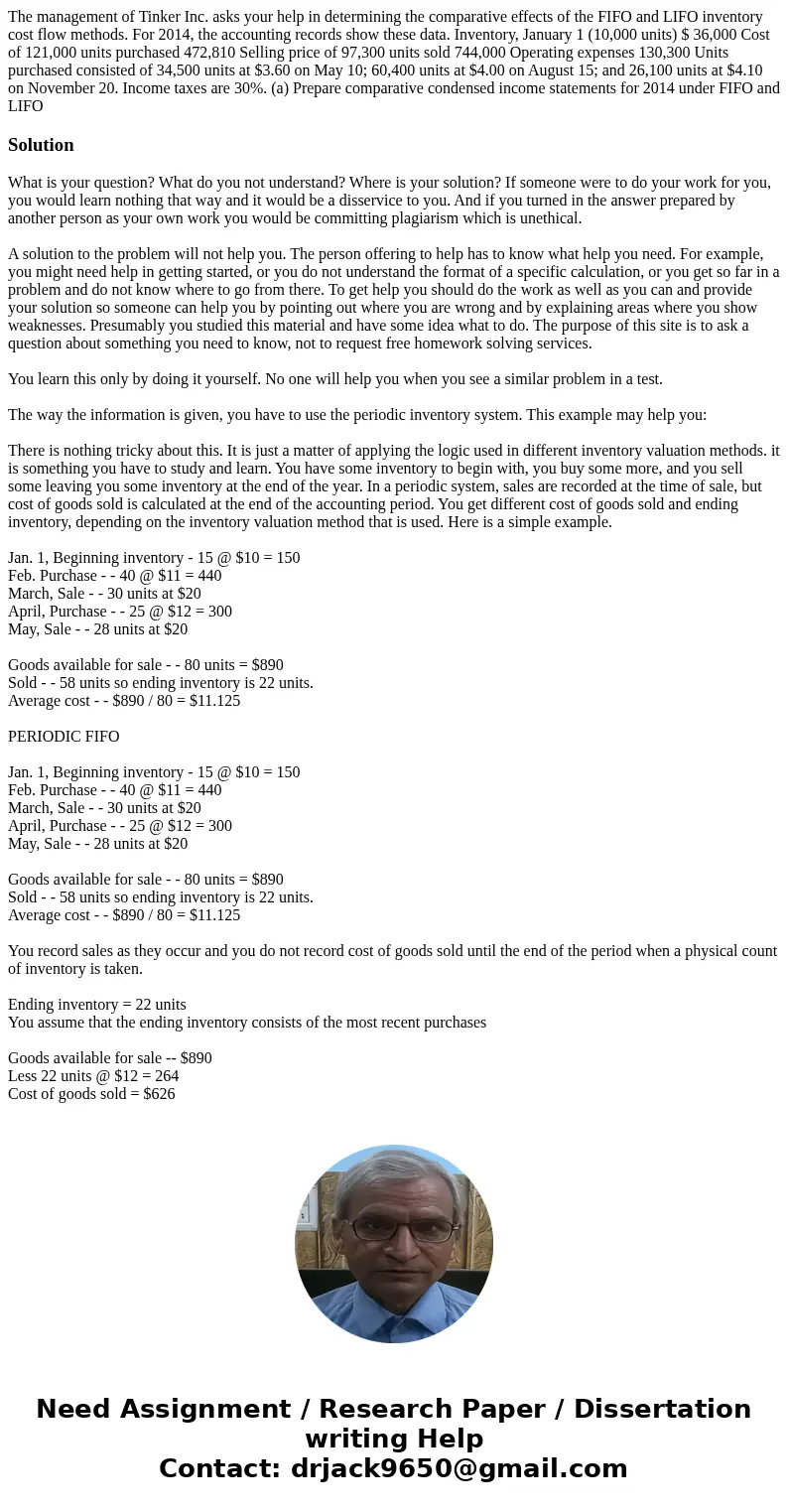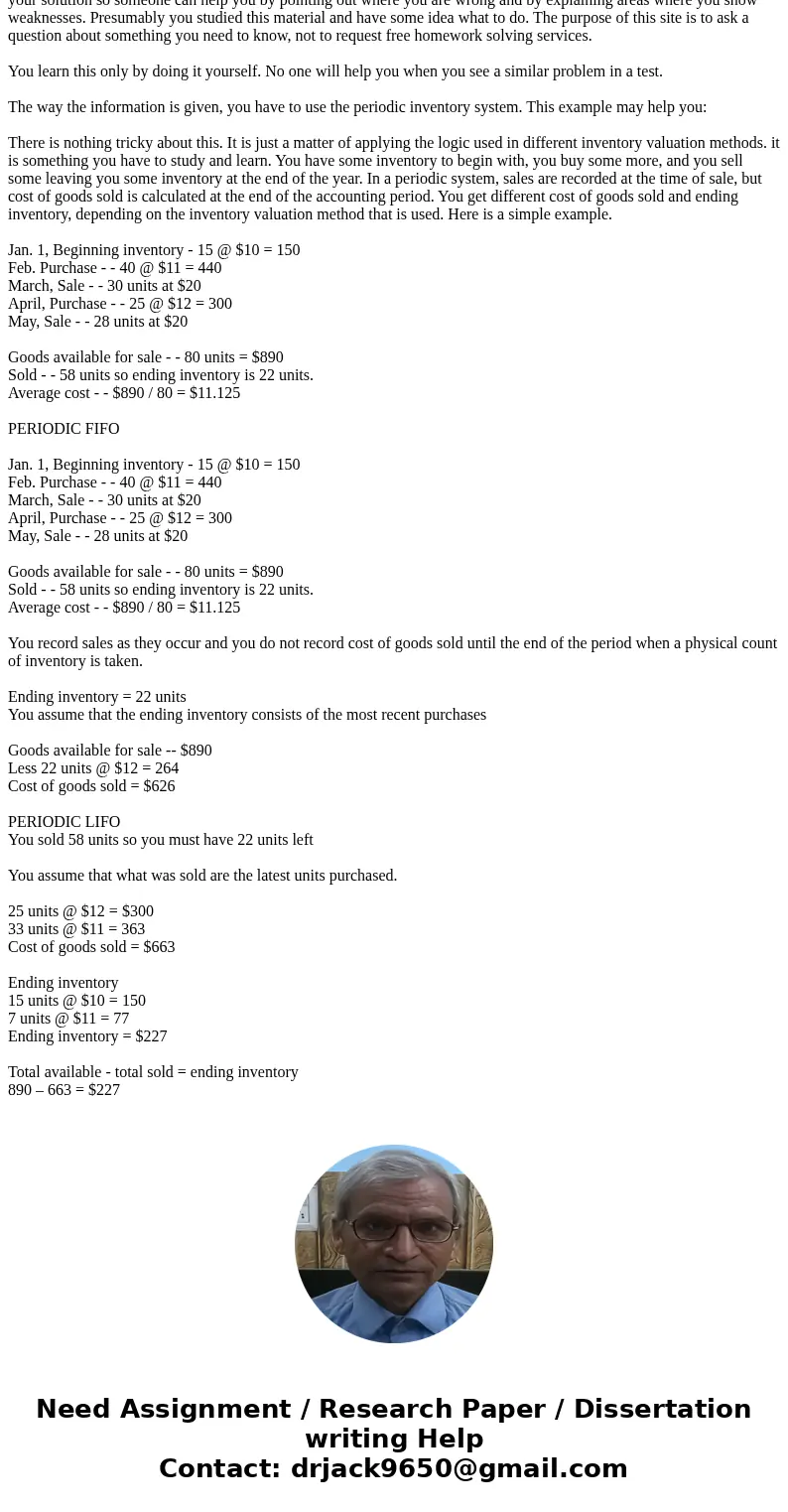The management of Tinker Inc asks your help in determining t
The management of Tinker Inc. asks your help in determining the comparative effects of the FIFO and LIFO inventory cost flow methods. For 2014, the accounting records show these data. Inventory, January 1 (10,000 units) $ 36,000 Cost of 121,000 units purchased 472,810 Selling price of 97,300 units sold 744,000 Operating expenses 130,300 Units purchased consisted of 34,500 units at $3.60 on May 10; 60,400 units at $4.00 on August 15; and 26,100 units at $4.10 on November 20. Income taxes are 30%. (a) Prepare comparative condensed income statements for 2014 under FIFO and LIFO
Solution
What is your question? What do you not understand? Where is your solution? If someone were to do your work for you, you would learn nothing that way and it would be a disservice to you. And if you turned in the answer prepared by another person as your own work you would be committing plagiarism which is unethical.
A solution to the problem will not help you. The person offering to help has to know what help you need. For example, you might need help in getting started, or you do not understand the format of a specific calculation, or you get so far in a problem and do not know where to go from there. To get help you should do the work as well as you can and provide your solution so someone can help you by pointing out where you are wrong and by explaining areas where you show weaknesses. Presumably you studied this material and have some idea what to do. The purpose of this site is to ask a question about something you need to know, not to request free homework solving services.
You learn this only by doing it yourself. No one will help you when you see a similar problem in a test.
The way the information is given, you have to use the periodic inventory system. This example may help you:
There is nothing tricky about this. It is just a matter of applying the logic used in different inventory valuation methods. it is something you have to study and learn. You have some inventory to begin with, you buy some more, and you sell some leaving you some inventory at the end of the year. In a periodic system, sales are recorded at the time of sale, but cost of goods sold is calculated at the end of the accounting period. You get different cost of goods sold and ending inventory, depending on the inventory valuation method that is used. Here is a simple example.
Jan. 1, Beginning inventory - 15 @ $10 = 150
Feb. Purchase - - 40 @ $11 = 440
March, Sale - - 30 units at $20
April, Purchase - - 25 @ $12 = 300
May, Sale - - 28 units at $20
Goods available for sale - - 80 units = $890
Sold - - 58 units so ending inventory is 22 units.
Average cost - - $890 / 80 = $11.125
PERIODIC FIFO
Jan. 1, Beginning inventory - 15 @ $10 = 150
Feb. Purchase - - 40 @ $11 = 440
March, Sale - - 30 units at $20
April, Purchase - - 25 @ $12 = 300
May, Sale - - 28 units at $20
Goods available for sale - - 80 units = $890
Sold - - 58 units so ending inventory is 22 units.
Average cost - - $890 / 80 = $11.125
You record sales as they occur and you do not record cost of goods sold until the end of the period when a physical count of inventory is taken.
Ending inventory = 22 units
You assume that the ending inventory consists of the most recent purchases
Goods available for sale -- $890
Less 22 units @ $12 = 264
Cost of goods sold = $626
PERIODIC LIFO
You sold 58 units so you must have 22 units left
You assume that what was sold are the latest units purchased.
25 units @ $12 = $300
33 units @ $11 = 363
Cost of goods sold = $663
Ending inventory
15 units @ $10 = 150
7 units @ $11 = 77
Ending inventory = $227
Total available - total sold = ending inventory
890 – 663 = $227


 Homework Sourse
Homework Sourse